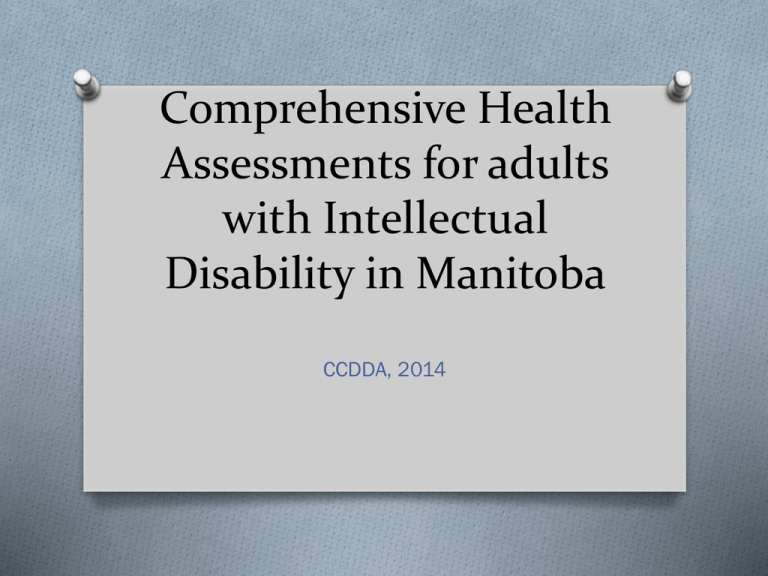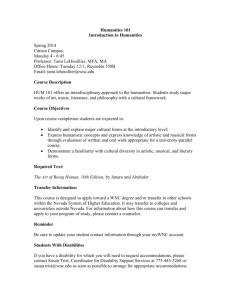
Comprehensive Health
Assessments for adults
with Intellectual
Disability in Manitoba
CCDDA, 2014
Research Team
Dr. Shahin Shooshtari, Faculty of Human
Ecology
Dr. Beverley Temple, College of Nursing
Celeste Waldman, RA, MN Student, Nursing
Sneha Abraham, Trainee, Community Health
Sciences
Background
O Research from Canada and abroad shows
that:
O Significant health disparities exist between
persons with and without ID (see Ouellette-Kuntz et al.,
2005, for a comprehensive review).
O Despite poorer health and higher health-care
needs, persons with ID experience more difficulty
accessing proper health care than the general
population [e.g., Janicki et al., 2002; Krahn, et al., 2006;
Bigby, 1998; Robertson et al., 2011).
Your Expectations
O How many of you have had an annual health
check/physical?
O Why do you have those ?
O What do you expect to accomplish by having a
physical?
O What kinds of screening have you had?
O Cancer checks – such as stool, colonoscopy, pap
tests, prostate checks, mammography?
O Eye, hearing, dental?
Background
O Different strategies have been suggested to
reduce health disparities for persons with
ID. For example: Comprehensive health
assessments
O The CHAP, an Australian-developed tool, was
designed to help minimize the barriers to
access primary health care for persons with
ID by prompting comprehensive health
reviews.
Background
O The effectiveness of the CHAP was
established through well-designed studies
[RCT; 450+ participants] (Lennox et al., 2007).
O increased health promotion, disease prevention,
and case-finding activity in the intervention group,
who received comprehensive health assessment
based on the CHAP.
O 30-fold increase in hearing testing; 9-fold
increase in rates of immunization; 8-fold increase
in women’s health screening, and increased
detection of new disease (e.g., diabetes, heart
disease) by 1.6 times.
Background
O The CHAP is a two-part booklet
O The caregiver will complete the first part
O The GP will complete the second part
O A list of conditions which are usually
unrecognized or poorly managed in
populations with ID (Page 15).
O A chart of syndrome-specific comorbidity,
which has proven useful for GPs (Page s
22-23).
Study Aim
O To determine the feasibility of implementing
the Comprehensive Health Assessment
Program (CHAP) for adults with ID in the
Province of Manitoba.
Study Method
O Interviews with
O
O
O
O
General Practitioners (GPs)
Nurse Practitioners (NPs)
Frontline Support Workers
Family Members
Providers or Families
O Question areas include:
O Breathing system – e.g does the person cough?
O Heart system – do they have chest pain? Ankles
O
O
O
O
swell?
Muscles and joints – do they have joint/back
pain?
Stomach and bowel – Lost weight, trouble
swallowing?
Urinary system – Pain when passing urine? Any
blood in urine?
Nervous system – are they unsteady on their feet
when walking?
Providers or Families
O Epilepsy?
O Types of seizures
O Drs. Seen for epilepsy
O Allergies
O Cause of Intellectual Disability
O Human Relations – sexual activity?
O Medications
O Prescription
O Over the counter
Providers or Families
O Women’s health – menstrual cycles,
O
O
O
O
O
O
contraception, etc
Pap smear, mammograms?
Men’s health – discharge from penis,
undescended testes?
Problem Behaviours
Mental Health
Vision
Hearing
Providers or Families
Dental
Blood Pressure
Cigarettes
Alcohol
Thyroid, Vit D test, Bowel cancer tests
Activity and lifestyle – mobility changes,
?exercise, diet?
O Immunizations
O Personal Medical history – e.g. surgeries
O Family History
O
O
O
O
O
O
Barriers and Facilitators
O Ideas of barriers to completing the
CHAP
O Ways to facilitate use
O What would you need to assist you to
complete the 1st part?
Barriers and Benefits
From GPs and NPs, some initial ideas that
have arisen include:
Barriers
• Time
• Payment
Benefits
• Assist practitioners to anticipate more
diseases to provide better care
• Potential difficulty in completing the action
plan – or follow-ups.
Next Steps
O We are organizing the ideas from all of the
interviews from Nurse Practitioners, and GPs
O We will be recruiting family members and direct
support workers to discuss their ideas of using
the CHAP
O Plan to meet with government to discuss
reimbursement of GPs who would be willing to
do the assessments
O Need to develop ways to measure success –
improved health of people with ID if we have
CHAP done.
References
O
O
O
O
O
O
Bigby, C. (1998). Shifting responsibilities: The patterns of formal service use by older
people with intellectual disability in Victoria. Journal of Intellectual and Developmental
Disability, 23(3), 97-109.
Janicki, M., McCallions, P., & Dalton, A. (2002). Dementia-related care decision-making in
group homes for persons with intellectual disabilities. Journal of Gerontological Social
Work, 38(1/2), 179-195.
Krahn, G., Hammond, L., & Turner, A. (2006). A cascade of disparities: health and health
care access for people with intellectual disabilities. Mental Retardation and
Developmental Disabilities Research Reviews,
Lennox, N., Bain, C., Rey-Conde, T., Purdie, D., Bush, R., Pandeya, N. (2007). Effects of a
comprehensive health assessment programme for Australian adults with intellectual
disability: a cluster randomized trial. International Journal of Epidemiology, 36(1), 139140.
Ouellette-Kuntz, H., Garcin, N., Lewis, M., Minnes, P., Martin, C., Holden, J. (2005).
Addressing health disparities through promoting equity for individuals with intellectual
disability. Canadian Journal of Public Health, 96 (S2), S8-S22.
Robertson, J., Roberts, H,. Emerson, E., Turner, S., Greig, R. (2011). The impact of health
checks for people with intellectual disabilities: a systematic review of evidence. Journal of
Intellectual Disability Research, 55(11), 1009-1019.











